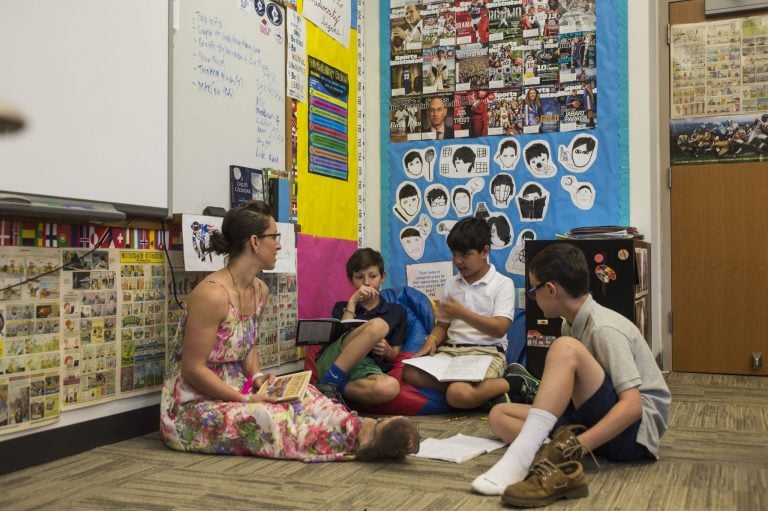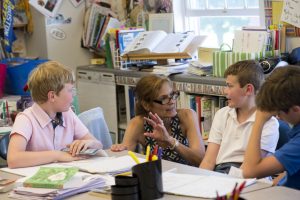Fourth Grade: Encouraging Complex Conversations
The need to educate socially adept global citizens and learners is more crucial now than ever before. Shaping compassionate, agile, and resilient children is becoming increasingly important in the 21st century, as complex national and global issues are omnipresent and we are connected by continually advancing technology. But when is the right time to address these issues with students?
 At Fessenden we believe it’s never too early to instill our core values of honesty, compassion, and respect in children. We begin our character education program in pre-kindergarten, for example. However, in fourth grade students are beginning to become self-aware and see themselves within the context of their environments. Because of this, it can be challenging for elementary school teachers to determine how to expose young children to complicated, real-world topics, but we believe it is important to lean into these conversations in age-appropriate ways.
At Fessenden we believe it’s never too early to instill our core values of honesty, compassion, and respect in children. We begin our character education program in pre-kindergarten, for example. However, in fourth grade students are beginning to become self-aware and see themselves within the context of their environments. Because of this, it can be challenging for elementary school teachers to determine how to expose young children to complicated, real-world topics, but we believe it is important to lean into these conversations in age-appropriate ways.
Here are a few things to look for in your child’s school, particularly its fourth grade program:
Cultural Competency as a Priority
Many schools today aim to create an educational environment that respects diversity and promotes inclusion, but not all programs are created equally. The work being done at Fessenden to foster cultural competency—or the ability to learn and work with people from diverse cultural backgrounds, and the development of skills to be successful in an increasingly global world—overlaps with the School’s character education program and its project-based learning initiatives.
In the fourth grade at Fessenden, students learn about different people who have demonstrated bravery and positively impacted the world, standing up for what they believe in. Fourth Grade Teacher Marjorie Hendrick believes that children are “exposed to so much more than we were; they hear it all on the periphery.”
She and her class study Bahrain in the Middle East each year, and students often make connections to what they’ve heard about the Middle East on the news, particularly modern-day Syria, the Israeli-Palestinian conflict, and issues in Iran and Iraq. “They’re interested,” Marjorie shares. “Whether they have a set of facts or misinformation in their minds, they have a foundation. They’re so inquisitive and they want to know more.
Teachers cannot be afraid that kids are too young to learn about certain issues. And, it’s even more important to focus on the good.” The students read an abridged version of “I Am Malala: The Girl Who Stood Up for Education and was Shot by the Taliban,” a memoir by Malala Yousafzai. Marjorie explains that it felt risky to introduce this material, but that students were moved by Malala’s story. When they made connections between the text and their own lives, Marjorie says, “I saw their little minds thinking, ‘Gee, it will make a difference if I stand up for what I believe in.’”
Understanding Cultural Identifiers
In 1976, anthropologist and cross-cultural researcher Edward T. Hall developed the Cultural Identifiers Iceberg of Differences to convey the various tiers of cultural identities. He reasoned that it is easier to study issues above the “waterline of visibility,” or issues that are obvious to the naked eye. These include gender, race, and physical ability. However, it is becoming increasingly important to expose students to items that are not readily visible, such as religion, family status, and life experiences. The crux of the iceberg model is that we cannot make judgments about a person or a culture based only on what is easily seen by the naked eye.
Lauren Maiurano taught fourth grade at Fessenden for several years before becoming the School’s innovation coach in the Lower School. In order to go beyond the “waterline of visibility,” she designed a project-based learning unit that challenged fourth grade students to develop empathy for people with disabilities, and to see beyond the disability. Her students worked with partners in the Ciongoli Center for Innovation to disable another group using recycled materials designed to constrict an action or make it cumbersome. Throughout this project, fourth graders learned about what it means to help others, and they became more understanding of the fact that people are not defined by their disabilities.
Using Literacy to Promote Awareness and Empathy
 Fourth Grade Teacher Marjorie Hendrick says when it comes to literature, you can’t be afraid to push the boundaries. She explains, “It’s very important to cover content that might seem more challenging. Our goal is to expose boys to lots of different types of people all over the world, because it will ultimately make them better people.”
Fourth Grade Teacher Marjorie Hendrick says when it comes to literature, you can’t be afraid to push the boundaries. She explains, “It’s very important to cover content that might seem more challenging. Our goal is to expose boys to lots of different types of people all over the world, because it will ultimately make them better people.”
Upper School Librarian Erika Hoddinott agrees, explaining that she is impressed with the content that is being written in today’s literature. She attests, “It’s a great time to be reading this material. Yes, the topics covered can get uncomfortable, but that’s a good thing. It leads to awareness and empathy.”
How do you feel about leaning into complex conversations? When do you think it’s appropriate? Tell us in the comments section below.




